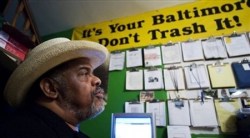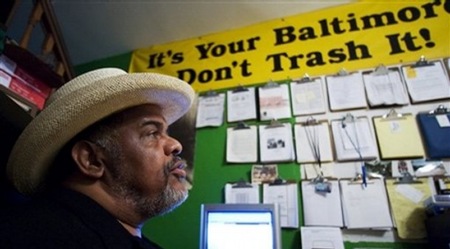 When Glenn Ross was a child, in the early 1960s, he liked to take a shortcut through a field of sunflowers on his way to school. “It was beautiful, all these yellow sunflowers,” Ross recalls. “We’d bring home the seeds and fry ‘em up with butter and salt.”
When Glenn Ross was a child, in the early 1960s, he liked to take a shortcut through a field of sunflowers on his way to school. “It was beautiful, all these yellow sunflowers,” Ross recalls. “We’d bring home the seeds and fry ‘em up with butter and salt.”
A charming memory, but for the fact that Ross grew up in an industrial section of East Baltimore and this bucolic scene bordered a steel plant. One day he was at the neighborhood playground when word went around that “men in spacesuits” were collecting the flowers. When he went to investigate, he says he saw workers in Hazmat gear harvesting the plants, having surrounded the area with caution tape. Many years later, Ross learned that sunflowers are used in phytoremediation projects to pull lead from the soil. (Trail mix, anyone?)
These days, the site — now a vast sorting facility for construction debris — is one stop on Ross’ Toxic Tour, a rollicking bus ride through the contaminated wonderland that is inner-city Baltimore. A self-described “urban environmentalist,” Ross leads dozens of tours a year, primarily for college students from Johns Hopkins University’s schools of medicine, nursing, and (wait for it) public health, which are located nearby. The tours take in brownfields, rat infestations, truck traffic, illegal dumping sites, vacant buildings, and other environmental hazards in Baltimore’s poor, predominantly black communities.
Ross, who has been leading them for nearly a decade, makes sure the bus windows are open for these warm-weather outings. “I put it right up in their face — they’ve got to smell it, taste it, the whole nine yards,” he says. “And at the end of the tour, they get it.”
“It,” says Ross, is nothing less than environmental racism. “These things only happen in poor urban communities, neighborhoods where there’s poor political representation.”
Ross has attacked his city’s glaring public health disparities from many angles. He’s been president of his neighborhood community association for nearly 20 years, has sat on boards and rubbed elbows with drug dealers, badgered and cajoled local politicians, sweet-talked nonprofits, and consulted for universities.
And after 40-some years of activism, he says he’s seen some small signs of progress. On his tours, he used to stop at an area along a set of railroad tracks where swathes of black fluid dripped down the walls and ultimately into the storm drains. These, he suspects, were not only locomotive fluids, but also toxic PCBs, used for insulating purposes. Now those walls are scrubbed clean. Students on his tours often take photographs along the way, and Ross attributes the improvements to the paparazzi effect.
Other changes? Ross’ neighborhood of McElderry Park will soon be home to 800 new street trees. His tours are starting to attract universities from outside the city and even the state, and in 2005, Hopkins’ aforementioned health schools set up a student outreach center to promote volunteerism in the communities they border. (Ross is the center’s “community consultant.”)
But residents of these communities still suffer disproportionately from a huge range of maladies, from asthma to cancer to lead poisoning (not to mention homicide). A recent city health department study found that the average resident’s life expectancy differs by as much as 20 years depending on the neighborhood they live in. In McElderry Park, it is less than 65 years.
So Ross has some friendly advice for well-meaning white environmentalists, several of whom have complained to him about their lack of success in urban areas: If you’re trying to win over poor, black folk from the inner city, spare them the plight of the baby seal.
“When you talk about the environment, you talk about the white snow-capped mountains, the salmon, the wildlife, kayaking,” he says, delivering a pregnant pause. “We don’t kayak.”
Instead, Ross says, environmental activists should focus on topics closer to home, like how local demolition is conducted, why it’s important to plant more trees, what’s causing kids to develop asthma, and where litter goes once it’s washed down the storm drain.
But as much as Ross enjoys schooling treehugging salmon-smoochers, they are not his target audience. “We’re the ones that’s living in this, we’re the ones that need to be educated about why our health is this way,” Ross says. “You know, Why’s my child’s asthma so bad? These are the people who need to know.”




